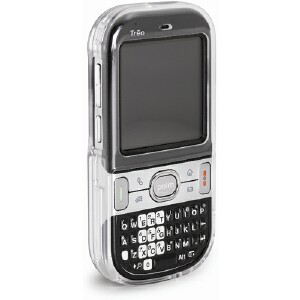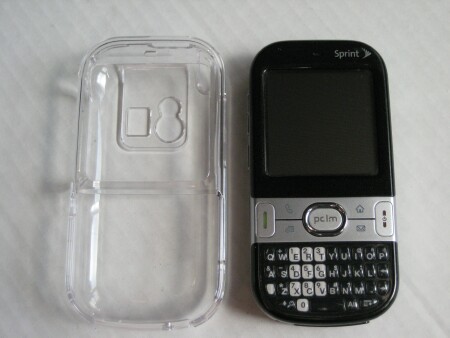
Plenty of accessories for the Centro are still long in coming. The OEM-sized extended battery comes to mind. Fortunately, that’s not the case for cases. Pretty much every type of case is available for the Centro: hard, soft, black, colored—and now, courtesy of Palm, clear.
Design and Usability
In keeping with the current diversity of cases, the Palm Centro Air Case is not the only case available for the Centro. The Seidio Super Slim Crystal Case for Centro is another contender, virtually identical, except for a cutout for the status light, and a shell that’s possible thinner. It’s difficult to make a definitive comparison between the two—unfortunately I don’t have access to the Crystal Case. Seidio’s marketing specifies a 1mm thickness, while Palm makes no specs available—only qualitative descriptions. In forums I’ve come across descriptions of the Air Case that put the thickness at 1.2mm, which seems accurate to my eyes. A 20% difference is definitely worth taking into consideration.

The Air Case is beautifully simple and straightforward, as should be expected with cases of this type. The clear polycarbonate shell is a 2-piece construction that snaps together quite easily. Taking it apart, on the other hand, is another story. I had more than a little trouble finding a way to liberate the Centro after struggling to pry the caseÂ’s halves apart. I even had a twinge of concern that I might have to resort to cracking the case if necessary. I would have preferred that Palm had designed one or two insets along the edge to offer some leverage for a coin or fingernail to wedge the case open without excessive force.
The best procedure to open the case is to life its top half from above the Athena connector, then lodge your thumbnail in the seam at the corner, to the right of the lanyard opening. If necessary, insert more fingernails at other points in the seam to add leverage when prying the halves apart. Once youÂ’ve managed to open the case for the first time, concerns about breaking the case through excessive force are greatly reduced.
As with virtually all hard cases, the cutouts are well-placed and well-designed, with more than adequate clearance for the Athena connector and audio jack. Often with cases, especially soft ones, the audio jack or power connector (the left end of the Athena connector) winds up partially covered by a millimeter or more. The rounded corners with tapered edges are a nice touch, preventing your thumb from getting pinched if slide into an edge. They also look better than angular cutouts. No cutout is provided for the microSD slot or IR port. The IR port is a non-issue with a clear case, but itÂ’s unfortunately the so many case manufacturers consider the memory card slot expendable.
There’s only so much I’m willing to do in the line of duty when testing for protection. The Air Case survived half a dozen 3”-to-7” drop tests without a scuff or scratch. In forums, some owners report the case surviving 3’ drops, with the case splitting apart at the seams, but with no further damage to the case or the Centro.
Conclusion
The Palm Centro Air Case does exactly what it was designed to do: provide robust protection thatÂ’s felt, but not seen. I really like looking at the Centro unobscured, and am glad to see (or, rather, not see) a case that preserves the phoneÂ’s look and functionality. Just be prepared to spend some time taking the case apart for the first time. Once youÂ’re used to removing it, the Air Case is as much a pleasure to use as it is to look at.
|
|
| Pros |
Leaves entire phone visible
Impact resistant
Adds very little weight to Centro
|
|
| Cons |
No cutout for microSD slot
Removal procedure is not obvious
Noticeably thick |
|